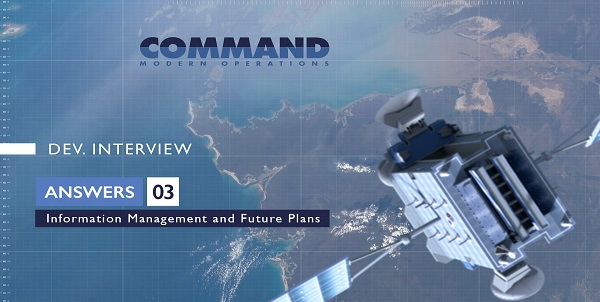Published on September 27, 2019
The third - and last - part of the Dev Interview on the upcoming Command: Modern Operations is available.
This time, a great focus on how the new system processes the huge amount of information, what changes have been done to the AI, new UI and menus, e many other additions.
Welcome to Information management and future plans
Feel free to comment on the forum

PART III : INFORMATION MANAGEMENT AND FUTURE PLANS
10) We can assume that AI will play a key role in C: MO, given that multiplayer won’t be added at release. Could you give us more details on how the AI has been improved?
The improvements to the AI in this release have been mostly incremental, in accordance with the “game first” direction. However, there are some new features that are likely to please new and existing players alike:
- In CMANO v1.x, ships and submarines may sometimes “hug the coast” a bit too tight when plotting their pathfinding routes, which can result in them getting stuck as they ‘surf the beach”. In CMO they now use a far more intelligent cost-based pathfinding algorithm which tries hard to keep them preferably in deeper waters (the tolerances depend on vessel size; small cutters are more willing to close to the coast than supercarriers). This results both in far more life-like navigation patterns and also effectively deals with “stuck on coast” issues.
- Aircraft have a number of improvements in their close air-combat logics. One of the most important is that now not only missiles but also enemy aircraft are considered threats to actively maneuver against. So for example in a typical Vietnam setup you may have a MiG-19 closing in on an F-105 egressing from a strike. In CMANO v1.x the Thud would not maneuver to avoid (or engage) the MiG even if the latter engaged with guns, as long no missile was launched. Now the Thud will watch out for the gun threat and start maneuvering against it as soon as the MiG gets within gun range.
- Significant change in unit AI logic: The "evaluate targets" and "evaluate threats" logics are now not performed on every pulse, but instead on regular intervals dictated by the OODA-Targeting (modified by crew proficiency) and OODA-Evasion values respectively. This has two effects:
- These two OODA values, and crew proficiency, become even more critical to a unit's effectiveness and survivability.
- Because these AI parts are called less frequently (and they are among the top CPU-killers), overall sim-core performance in large/complex scenarios is significantly improved.
- One of the biggest improvements on the AI side is that you can disable it (bet you didn’t see this coming :). Specifically, you can selectively disable numerous AI functions through the Lua API and then implement your own logic to override them. This allows scenario authors to more easily create their own custom AI behaviors. It can also allow much bigger scenarios with lots of neutral/non-active units, since these can be instructed to skip their AI checks altogether, thus radically improving performance.
READ THE FULL INTERVIEW HERE







